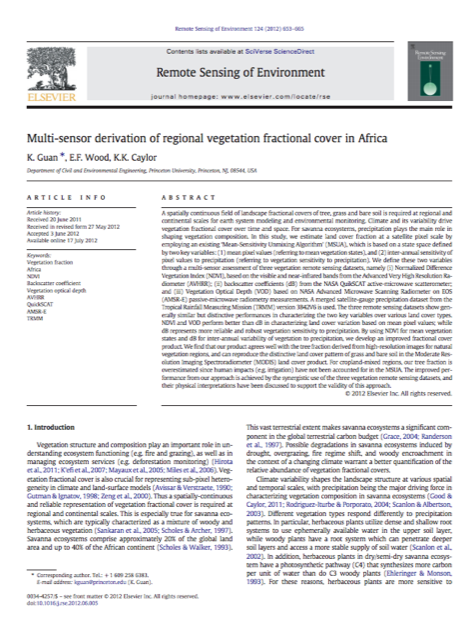Multi-sensor derivation of regional vegetation fractional cover in Africa

*Guan, K., Wood, E.F., Caylor, K.K. (2012) “Multi-sensor derivation of regional vegetation fractional cover in Africa”, Remote Sensing of Environment, doi:10.1016/j.rse.2012.06.005.
A spatially continuous field of landscape fractional covers of tree, grass and bare soil is required at regional and continental scales for earth system modeling and environmental monitoring. Climate and its variability drive vegetation fractional cover over time and space. For savanna ecosystems, precipitation plays the main role in shaping vegetation composition. In this study, we estimate land cover fraction at a satellite pixel scale by employing an existing ‘Mean-Sensitivity Unmixing Algorithm’ (MSUA), which is based on a state space defined by two key variables: (1) mean pixel values (referring to mean vegetation states), and (2) inter-annual sensitivity of pixel values to precipitation (referring to vegetation sensitivity to precipitation). We define these two variables through a multi-sensor assessment of three vegetation remote sensing datasets, namely (i) Normalized Difference Vegetation Index (NDVI), based on the visible and near-infrared bands from the Advanced Very High Resolution Radiometer (AVHRR); (ii) backscatter coefficients (dB) from the NASA QuikSCAT active-microwave scatterometer; and (iii) Vegetation Optical Depth (VOD) based on NASA Advanced Microwave Scanning Radiometer on EOS (AMSR-E) passive-microwave radiometry measurements. A merged satellite-gauge precipitation dataset from the Tropical Rainfall Measuring Mission (TRMM) version 3B42V6 is used. The three remote sensing datasets show generally similar but distinctive performances in characterizing the two key variables over various land cover types. NDVI and VOD perform better than dB in characterizing land cover variation based on mean pixel values; while dB represents more reliable and robust vegetation sensitivity to precipitation. By using NDVI for mean vegetation states and dB for inter-annual variability of vegetation to precipitation, we develop an improved fractional cover product. We find that our product agrees well with the tree fraction derived from high-resolution images for natural vegetation regions, and can reproduce the distinctive land cover pattern of grass and bare soil in the Moderate Resolution Imaging Spectroradiometer (MODIS) land cover product. For cropland-mixed regions, our tree fraction is overestimated since human impacts (e.g. irrigation) have not been accounted for in the MSUA. The improved performance from our approach is achieved by the synergistic use of the three vegetation remote sensing datasets, and their physical interpretations have been discussed to support the validity of this approach.
